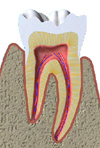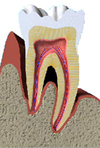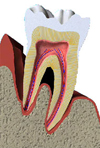Gum disease
What is gum disease?
Gum disease is manifested by swelling and inflammation of the gums. There are two main forms of gum disease, gingivitis and periodontosis.
What is gingivitis?
With gingivitis, the gums will swell and turn red. Often bleeding gums occur when brushing.
What is periodontosis?
A long-lasting gingivitis can eventually become periodontitis. There are different forms of periodontitis that all affect the gum tissue. As the disease progresses, the teeth lose their grip in the jaw. If they are not treated, they may fall out.
What is the probability that I will get this disease?
Most people suffer from some form of gum disease and this is also the reason for the loss of teeth in adults. However, the disease develops quite slowly in most people, and it can be burned by the daily removal of plaque so that most teeth are preserved for a lifetime.
What is the cause of gum disease?
All dental diseases are caused by plaque or dental plaque. Plaque is a film of bacteria that form on the surface of the teeth daily. Many of the bacteria in the plaque are completely harmless, but there are also those that are the main cause of gum disease. To avoid gum disease, she should remove the plaque daily. This is done by brushing as well as flossing.
What happens if gum disease is not treated?
Unfortunately, gum disease progresses largely without pain and therefore it is often noticed too late what damage has been done. Sometimes, however, the bacteria are more active, which manifests itself in inflammation. This can also develop into an abscess and pus formation. Over a longer period of time, the adhesion in the jaw is lost and teeth fall out. If the disease remains untreated for a longer period of time, successful treatment can be quite difficult.
How do I know if I have gum disease?
The first signs of blood when brushing or rinsing indicate this. The gums may also start bleeding when eating, leaving an unpleasant taste in the mouth. Bad breath can also develop in this way.
What is the best thing to do if I think I have gum disease?
It is best to have your teeth and gums thoroughly examined by your dentist. The dentist can measure how far the gums have already retracted and can determine whether there are signs of periodontitis on both sides. X-rays provide information about whether the jaw is already damaged These examinations are necessary to determine the most promising therapy possible.
What treatment is necessary?
Your dentist will prescribe a general cleaning of your teeth. You will be shown how plaque can be removed as well as possible and all areas of the teeth cleaned. This often requires several sessions.
What else is needed?
When your teeth are cleaned, the dentist may decide to clean the roots as well to make sure that all bacteria have been removed from the gingival pockets.
What is the probability of suffering from periodontitis again?
Periodontal disease is never cured. But as long as you keep up the home care you have been taught, any further loss of bone will be very slow and it may stop altogether. However, you must make sure you remove plaque every day, and go for regular check ups by the dentist and hygienist.
 |
 |
 |





